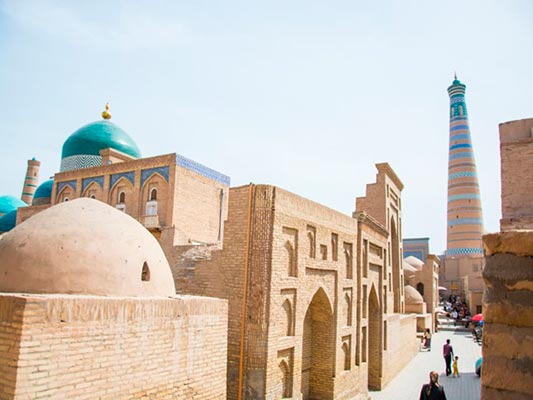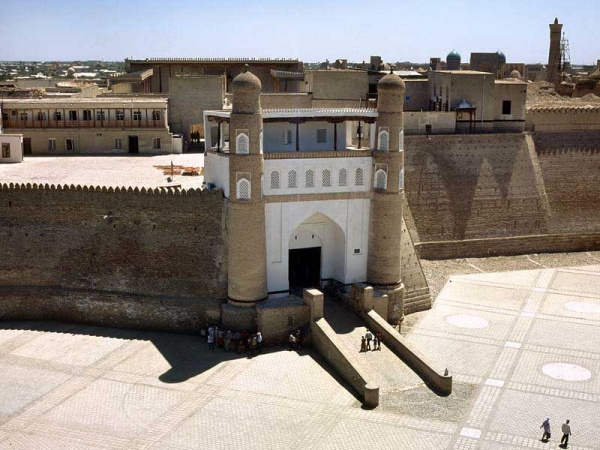Turkmenistan-Uzbekistan
- Itinerary
- Photos
- Reviews(0)
Description
Airport pick-up, hotel check-in.Then time to explore Turkmen culture.
Shopping or just walking around famous bazaar called “Tolkuchka”. This bazaar shows works of Turkmen craftsmen in a national style: rugs, jewelry, oriental robes, Arabian camels. Discover the colors of Central Asia market. Start sightseeing in Ashgabat & visit the Neutrality arch, Independence park, National museum of history. Overnight at hotel.
Visit the archeological site “Old Nisa”, UNESCO world heritage site from 2007, Turkmenbashy mosque. Discover Ahal Teke horses at private horse farm. Return in Ashgabat and visit Ertogrul Ghazi Mosque and Turkmen Carpet Museum. Night sleep in the hotel.
Day 3 plan is to cover the distance of 500 kilometers. Tourists will go to Darvaza settlement. Leave the road & discover the Fire Gas Crater. Return drive & visit Erbent village on the route. Discover landscapes of Kara Kum desert. Night sleep in the hotel.
From Ashgabat to Mary.From Mary further to Merv. Merv is an ancient city. It is located in the center of the oasis by the delta of the river Murgab. This place is not far from the area, where the river was flowing long long time ago. The area of Merv at one point in time reached more than 1000 hectares. This city in 1999,was included in the list of World Heritage sites by United Nations. Tourists will spend this night in the hotel in this historical place.
Drive to Gonur (Margiana) archeological site. The part of the Bronze Age archaeological sites dating from 2200 to 1700 B.C. At this place you can still witness remains of the Bronze Age civilization that was mainly settled on the upper part of Amu Darya River, also known as Oxus, The sightseeing for the day also include theBactria-Margiana Archaeological Complex (BMAC). Margiana was the Greek name for the Persian province of Margush.
Visit the excavations: even remains of this place give clear understanding of how people lived in this place. In particular they were busy with agriculture and breeding cattle. People in Margiana developed complicated irrigation systems. There were craftsmen who supplied the population with ceramics. For defense purposes people surrounded Margiana city with walls. Inside the city there were one story constructions that served different purposes, such as: houses for living, temples,funeral chambers, and even observatories, according to opinion of some researchers. During Necropolis archeological digs there were found some objects that were made in foreign countries. This indicates that Margian population had trade with different regions and countries, including Indus Valley and Egypt.Drive back to Mary. Night sleep in a hotel.
Cross Karakum desert, Amudarya river& Sundukli barchans, arriving early evening in Bukhara.
Check in hotel. Leisure & O/N.
During day 7, tourists stay in Bukhara for sightseeing. Our first sight is Samanid’s Mausoleum, dated 9-10th century. The mausoleum is the place where family members of Samanids’ dynasty were buried. This construction has distinctive architecture that stands out of the rest architectural designs of that time in Central Asia. For that time it was the first structure that opened new era in Central Asian architecture. At the time of Arabic invasion the monument was damaged and after that reconstructed. Then we move further to see Chashma Ayub Mazar, dated back to 14-19th centuries. It is a burial vault with monuments. The next stop is Poi Kalyan Complex (12-16th centuries. The complex consists of widely known 49 meter high Minaret Kalyan. The minaret was built in 1127. Fortunately, despite a series of wars and conquests it was not destroyed.Minaret Kalyan served different purposes throughout its history. Once it was used as a look-out station next time it became the place for public executions. It is a subject to a lot of different stories and tales. During the tour, our guide will tell you most famous out of them.Next in the program is Lyabi Hauze Complex. The complex consists of Kukeldash and Nodir Divan Begi Madrassas, built in 1568 and in 1622 respectively. One of the most ancient constructions in this area is Ark Fortress. It is dated back to 6-7th century. This is the last object in sightseeing of day 7. Back to the hotel for a night sleep.
In the morning after breakfast is finished, there is a trip to one of the most well-known and ancient cities in Central Asia. At the same time it is one of the richest for cultural and historical heritage. Samarkand played significant role in the trade along Great Silk Road. Thanks to the preservation of ancient buildings, the city can reproduce atmosphere of Middle Ages. In addition, Samarkand has all the attributes of a modern city for a comfortable stay. Many geographers, poets and historians admired and still admire the beauty and uniqueness of Samarkand.Indeed, this city deserves it. Development of the city was influenced by a number of different cultures such as: India, China, Iran. Other nations’ experience, styles and expertise was mixed and it brought amazing results. There is no clear version of the city’s name origin. It is believed that “Samar” was the founder’s name and “kent” translates as “settlement/city”/
In the morning we will explore one of the most famous squares in Central Asia – Registan. It was built in 17th century. The square is the complex of constructions that consists of Sher Dor, Ulugbek and Tillya-Kory Madrassas. Translation of “Registan” is “sandy place”. It was a work place for trade people and craftsmen. Grandson of Amir Temur started construction of Ulugbek Madrassa in 1417. Three years later construction was finished. This madrassa became a scientific hub at that time and played important role in Central Asian science. In comparison to Sher Dor and Tilla-Kori Madrassas, Ulugbek Madrassa has no purpose to show wealth and beauty. It has rather simple design. Despite of this, this historical building is not less valuable. Later in 17th centuries were built two other madrassas that are a part of Registan Square. “Sher Dor” translates as “building with lions”. The exterior of this madrassa is decorated with pictures of an unknown animal that reminds a cat. Sher Dor stands opposite to the Ulugbek Madrassa and is its mirror image. Construction lasted for seventeen years at times of Yalangtush Bakhadur’s ruling. 10 years later was built last madrassa – Tillya-Kori. It is located on the north side of the Registan square. “Dressed by gold” is an English translation of the name. Registan was and still is significant for our country. Sightseeing continues with the visit of Gur Emir Mausoleum. This mausoleum is a tomb for members of Timurids’ dynasty. Remains of one of the greatest governors Amir Temur are kept there. After that we go to see: Rukhabad necropolis and Bibi-Khanum, both built in 15th century;Ulugbek’ s observatory of 15th century with unique astronomy equipment called “sextant”; Shokhi-Zindan Complex of 12-15th centuries; Khazrat-Khyzra, built in 19th century and some more monuents. Returning back to Bukhara to spend time visiting places of your own interest. Night 10 is spent in the hotel in Bukhara. 6-7 hour trip to Khiva will start early in the morning. On our way you will have the opportunity to get acquainted with the nature of Kyzyl-Kum desert. There are still the evidence of trade caravans from times of Great Silk. Arrive in Khiva. Overnight at hotel. Khiva is an ancient city that has great historical sights to visit. This whole day is dedicated to this beautiful city. Khiva is considered to be museum under open sky, because almost everything in this city preserved original design. Everywhere you go in this city you will see old buildings. The city has a 2500 year history. We will visit Ichan-Qala walls. Inside these walls there is an clear feeling that we are at ancient times. The atmosphere is unbelievable, magical and very strong. You can imagine this place to be a place where heroes of Shakhirizada tales live. Every single thing inside these walls is left untouched and you can understand why Khiva is called museum under open sky. Then you will visit 58 meters high Minaret Islam-Hoja. There will be an opportunity to look down the city from the top of the minaret.The view is breath taking. When back on the ground, go to Djuma Mosque of 10-11th centuries. A distinctive feature of this construction is that it has 218 decorative columns inside, each column with different ornament. There are no two columns with the same ornament. Next in the program are Minaret Kalta-Minor (1835), Museum of Avesta or Wildlife Museum.This day in Khiva is emotionally rich and there will be a rest after sightseeing. Day 13 starts with crossing the Uzbek-Turkmen border to get to Kunya Urgench. At the beginning, Old Urgench was located by the river Amu-Darya and played important role in Great Silk Road existence. It is unclear when the city was built, but particular constructions was dated back to the ruling of Achaemenids. Kunya Urgench was at the peak of prosperity from 12th till the beginning of 13th centuries. At that time it was one of the most influential Central Asian cities. In 1221, After Genghis Khan invasion in 1221, the city was destroyed. Cruelty of Genghis Khan’s attacks left almost nothing. Later Kunya Urgench was rebuilt, but this time Amu-Darya destroyed the city, by changing its course. It happened in 1370 at the time of Amir Temur, who ordered city’s population to leave the city. In 2005 UNESCO included remains of Old Urgench in the list of World Heritage Sites and took it under its protection. Come back to Dashoguz. Flight to Ashgabat.Night sleep at the hotel in Ashgabad. Taking a flight in Ashgabad airport back home.
Related accommodations
Combined tour Uzbekistan-Kyrgyzstan
1 starTORUGART – TASH RABAT - NARYN - ISSYK KUL – BISHKEK - TASHKENT – BUKHARA – GIJDUVAN – SAMARKAND - TASHKENTBasic Tour 4 days
4 starsTashkent – Bishkek-Cholpon Ata– Almaty– SeoulCombination of countries for 2019 (KG-UZ August)
4 starsKyrgyzstan – Uzbekistan/ Bishkek- Issyk-kul – Song kul- Kelimche- kyzart- Kyzyl oi – Arslanbob – Uzgen – Osh- Tashkent – Samarkand – Bukhara- TashkentCombination of countries for 2019 (UZG-KGJune)
4 starsKyrgyzstan – Uzbekistan/ Tashkent – Khiva – Tashkent - Osh- Uzgen- Arslanbob- Kyzyl oi - Kelimche- kyzart-––– Song kul- Issyk-kul –Bishkek











